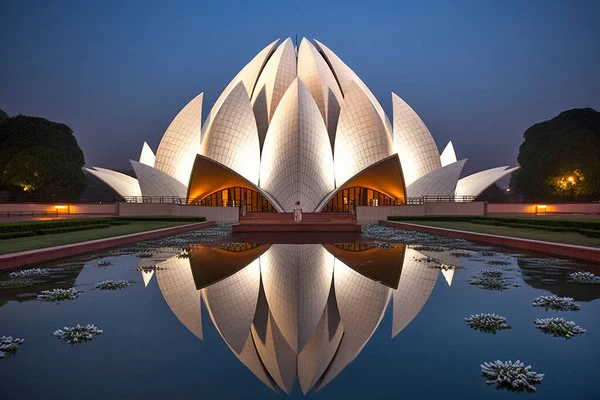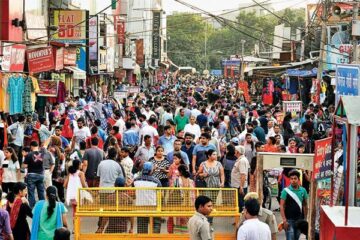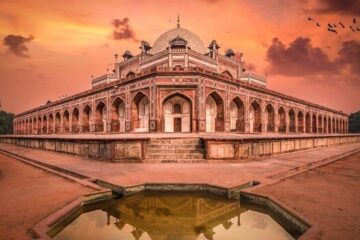Lotus Temple

The Lotus Temple, also known as Kamal Mandir, is one of the top tourist destinations in the country’s capital and a unique architectural wonder. With its stunning white petals shaped like a lotus, it is worth a visit and attracts a steady stream of tourists throughout the year. Unlike most other places of worship, this temple, also known as the Bahá’í House of Worship, does not follow a set schedule for worship and does not allow ceremonial rites. This house of worship, a magnificent representation of unity, should be on your schedule while making travel and accommodation arrangements in Delhi.
Are you curious to know more? This article has all the information you need about the Lotus Temple of Delhi, including information about its background, layout, hours and other features.
Lotus Temple Information:
| Location | Lotus Temple Road, Kalkaji |
| Timings | October to March: 9:30 am to 5:30 p.m.; April to September: 9:30 am to 7:00 p.m. *Closed on Mondays |
| Entry Fee | Free |
| Camera | There are no camera charges, but you need to get special permission for photography |
| Nearest Metro Station | Kalkaji Mandir |
| Status | Bahai House of Worship |
| Prayer Timings | 10 AM, 12 PM, 3 PM, 5 PM |
| Best Season to Visit | October to March |
| Established in | 1986 |
| Area | 26 acres |
| Material Used | Marble |
| Architect | Fariborz Sahba |
| Cost of Construction | 10 million dollars |
Lotus Temple: History
The Lotus Mashriqul-Adhkar Temple, a Bahá’í house of worship in Delhi, first welcomed visitors in December 1986. Its dedication to the unity of the religions and humanity is similar to that of all other Bahá’í temples. All religions are welcome to come together here for scripture reading, prayer and worship. One of the seven major Bahá’í houses of worship in the world, and the only one in Asia, is the Lotus Temple in Delhi.
Lotus Temple: What to do
The Lotus Temple welcomes anybody interested in participating in any of the four primary, or “core,” activities. You will also learn about Lotus Temple and Baha’i beliefs through these activities. Among them are:
- Children’s Classes: These classes aim at imbibing values such as generosity, justice, kindness, unity, courage, truthfulness, reliance on God, and service to humanity through Bahai teachings.
- Junior Youth Classes: These classes seek to develop spiritual and intellectual capacities in children aged 11-14 years.
- Devotional Meetings: These sessions are aimed at creating a loving and harmonious environment within the community.
- Study Circles: These meetings are aimed at making a comprehensive study of Bahai Writings, Prayer, and Life and Death, and hence create a spiritual consciousness among the people.
Lotus Temple: Architecture
Spread over 26 acres, this lotus-inspired building is surrounded by lush gardens. Made of white marble imported from Greece, it has 27 free-standing petals. As described in Bahá’í scripture, these petals are arranged in groups of three to give the building a nine-sided circular shape. There are nine doors leading to a huge central hall that extends to a height of about 40 metres. The temple can accommodate 2500 people at a time and has 1300 seats available.
As in all Bahá’í houses of worship, the Lotus Temple is devoid of altars and pulpits. There are no statues, paintings or other images inside. The nine pools of water around the petals are an attractive element of the temple. The structure looks spectacular when illuminated at night, giving the image of a half-bloomed lotus in a body of water.
An Iranian-American architect named Fariborz Sahba designed the temple, while the UK firm Flint and Neal handled the structural design. ECC Construction Group of Larsen & Toubro Limited was responsible for the construction of the temple, which was completed at a cost of $10 million.
Lotus Temple: Today
Presently, Lotus Temple is one of the most popular religious and tourist places in Delhi. The temple is one of the most visited buildings in the world, having welcomed more than 70 million tourists by the end of 2001. The Indian government reports that more than 100 million people have visited the temple as of April 2014. The temple has received many accolades for this. Captivating architecture is regularly featured in magazines, television shows, and films.
Lesser-known facts about Lotus Temple
- About 4.5 million people visit it annually, making it one of the most popular buildings worldwide.
- India has a postage stamp worth ₹6.50 that depicts the temple.
- Given that the lotus is a prevalent symbol in Islam, Buddhism, Jainism, and Hinduism, Fariborz Sahaba chose it.
- This is the first solar-powered temple in the country’s capital.
- Bahá’í follower Ardishur Rustampur of Hyderabad in the Sindh province of Pakistan gave all his wealth to finance the temple property acquisition.
Lotus Temple: How to Reach
Lotus Temple is conveniently located near the city thanks to a number of transportation choices. Among them are:
- By Road: There are 8–10 bus routes by DTC that pass near the Lotus Temple. There are options for cabs and autorickshaws as well.
- By Metro: Lotus Temple’s nearest metro station is Kalkaji, with a distance of 500m from the temple.
- By Train: New Delhi Railway Station is the nearest to the temple.
- By Air: Indira Gandhi International Airport is the nearest airport to the temple.
- Places to Stay nearby: Hotels near Lotus Temple
Attractions near Lotus Temple
- Kalkaji Devi Temple (600 m)—Kalkaji Mandir is a temple dedicated to Goddess Kali. Kalkaji Mandir is one of the busiest Hindu temples in Delhi. Kalkaji metro station is also the nearest metro station to Lotus Temple.
- ISKCON Temple (2.6 km): Sri Sri Radha Parthasarathi Mandir, generally known as the ISKCON Delhi temple, is a well-known Vaishnav temple of Lord Krishna and Radharani in the form of Radha Parthasarathi.
- Humayun’s Tomb (6.5 km): Humayun’s Tomb is another UNESCO World Heritage Site and a remarkable example of Mughal architecture. It is the tomb of the Mughal Emperor Humayun and is surrounded by beautiful gardens.
- India Gate (8.6 km): India Gate is a war memorial located in the heart of New Delhi. The monument is surrounded by vast lawns, making it a popular spot for picnics and evening strolls.
- Qutub Minar (9.8 km): The Qutub Minar is a UNESCO World Heritage Site and one of the most famous historical landmarks in Delhi. It’s a towering minaret made of red sandstone and marble, standing at a height of 73 meters. There are a lot of commuting options from Lotus Temple to Qutub Minar via bus, metro, or cab.
- Lodhi Tomb (10 km)—Lodhi Gardens is a historical park with beautifully landscaped gardens and historical monuments from the 15th-century Sayyid and Lodhi dynasties.
- Akshardham Temple (13.1 km): The Akshardham Temple is a modern Hindu temple complex known for its stunning architecture and intricate carvings.
Located in the bustling capital of India, the Lotus Temple is a peaceful place where you can worship and contemplate. You can also see one of the most amazing constructions in the world at the same time here. Why not arrange a visit to Delhi’s Lotus Temple and take some time out to appreciate its peace and beauty?



5 Comments
Kalka Ji Mandir Delhi (Timings, History, Entry Fee, Images, Aarti, Location & Phone) · February 24, 2024 at 3:29 pm
[…] 1. Lotus Temple: Also known as Baha’i Temple, Delhi’s Lotus Temple is a little over a 10-minute walk from Kalka Ji Temple. The strikingly beautiful lotus-shaped architecture of this building attracts the most curious travellers to this temple, which is open to people of every religion. Surrounded by sprawling greens and ponds on each side, the Lotus Temple has 9 faces and 27 petals in all. […]
Holi 2024 Date & Time, Holika Dahan Shubh Muhurat, & Importance · February 25, 2024 at 3:26 pm
[…] Holi 2024 […]
Agra Fort: Details, Hours, Ticket Price, and Structure · May 25, 2024 at 1:47 pm
[…] Lotus Temple, Delhi: Location, Facts, History, and Architecture […]
Delhi's Hauz Khas Village: ✏Time, Place, Admission Price, and and Background · June 5, 2024 at 2:38 pm
[…] Lotus Temple (7 km) […]
Akshardham Temple Delhi, Ticket Price, Musical Water Show Timing · June 5, 2024 at 2:45 pm
[…] Lotus Temple: Approximately 6 km away, the Lotus Temple is a stunning example of contemporary architecture and a Bahá’í house of worship. It is renowned for its serene atmosphere and design inspired by lotus flowers. […]